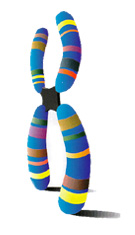Friday, January 29, 2010
Bird-Dinosaur in Technicolor
"Which came first, the chicken or the dinosaur egg? That one's a cinch. Less obvious is the riddle of kinship. Most scientists think birds evolved from dinosaurs about 150 million years ago. But a sparse fossil record has provided ammunition to those who insist that birds arose independently. A stunning new fossil makes that idea virtually untenable. And a second paper this week brings dinosaur feathers vividly to life, offering new clues to why this instrument of flight first evolved in flightless creatures." Full article @ Science.com.


Labels: evolution
Wednesday, January 27, 2010
lack of evolvability of autocatalytic networks
"In sharp contrast with template-dependent replication dynamics, we demonstrate here that replication of compositional information is so inaccurate that fitter compositional genomes cannot be maintained by selection and, therefore, the system lacks evolvability (i.e., it cannot substantially depart from the asymptotic steady-state solution already built-in in the dynamical equations). " Paper @ PNAS.


Labels: autocatalysis, evolution, origin
Horizontal and vertical: The evolution of evolution
"Just suppose that Darwin's ideas were only a part of the story of evolution. Suppose that a process he never wrote about, and never even imagined, has been controlling the evolution of life throughout most of the Earth's history. [...] At the root of this idea is overwhelming recent evidence for horizontal gene transfer - in which organisms acquire genetic material "horizontally" from other organisms around them, rather than vertically from their parents or ancestors. The donor organisms may not even be the same species. This mechanism is already known to play a huge role in the evolution of microbial genomes, but its consequences have hardly been explored." Full article @ The New Scientist.


Labels: evolution, horizontal gene transfer
Tuesday, January 26, 2010
Synthetic systems biology
"Synthetic biology goes beyond classic genetic engineering as it attempts to engineer living systems to perform new functions not found in nature. Ten years ago this week, Nature published a pair of seminal papers that stimulated 'systems biology' thinking in the field. This web focus gathers these two papers together with papers more recently published by Nature in the same spirit."
Labels: synthetic biology, systems biology
Friday, January 22, 2010
Amoeba-Inspired Network Design
"Self-organization, self-optimization, and self-repair as it naturally occurs in the slime mold Physarum polycephalum are capabilities that may be required for technological systems such as mobile communication networks or networks of dynamically connected computational devices." Full article @ Science.
Labels: biomimetics
Wednesday, January 20, 2010
Engineering cellular synchrony
"Scientists have engineered bacteria that can communicate with each other in a synchronized manner, lighting up in waves of fluorescent green [...] The engineered cells also offer a new model system for studying emergent systems, or how complex properties -- such as synchronized oscillation -- arise from simpler starting materials -- a two genes network." Full article @ The Scientist.


A supernova burst in a colony of coupled genetic clocks after critical cell density.
Image: Tal Danino, Octavio Mondragon-Palamino, Lev Tsimring
Labels: bacteria, complexity, dynamical systems
Thursday, January 14, 2010
The Extended synthesis
"Should Evolutionary Theory Evolve? Some biologists are calling for a rethink of the rules of evolution". Nice discussion of topics calling for more research in evolution. Full article @ The Scientist.
Labels: evolution, evolvability
Thursday, January 07, 2010
Another source of useful variation
"Traces of genetic material from non-retroviruses have unexpectedly turned up in the genomes of several mammal species, including humans." See commentary @ The Scientist. The actual report:
Horie1, M. et al [2010]. "Endogenous non-retroviral RNA virus elements in mammalian genomes". Nature 463, 84-87.

Horie1, M. et al [2010]. "Endogenous non-retroviral RNA virus elements in mammalian genomes". Nature 463, 84-87.

Wednesday, January 06, 2010
RNA Activation
"More findings confirm that small RNAs work in mysterious ways. Nearly 20 years after its discovery, RNA interference (RNAi) is part of biology’s orthodoxy. Small RNA molecules can disrupt gene expression by degrading messenger RNAs (mRNAs) on their way to becoming proteins, or otherwise interfering with translation. But the discovery that these same small RNA molecules might be able to do just the opposite—enhance gene expression—was somewhat heretical". Full article @ The Scientist.com.


Labels: RNA, transcription

